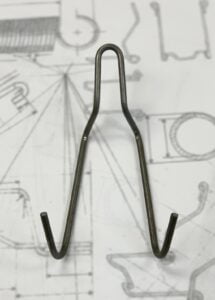Do you need to incorporate a wire form into your assembly? At Gifford Spring, we actively engage in wire form design discussions with our customers, offering cost-effective solutions to enhance strength, functionality, and precision in assemblies.
Wire forms can often serve as more affordable alternatives to metal castings and machining. In this article, we will explore design tips for incorporating a wire form into your assembly and discuss the advantages of each approach.
1. Constrain within assembly
By constraining a wire form within an assembly, you can reduce production costs by eliminating the need for secondary operations like threading or flattening the ends of the part. Here are a few methods to achieve this:
- Press Fit: The wire form is not physically fastened to the assembly but is instead constrained by other components. For instance, it is woven into a fabric or embedded in a plastic mold.
- Pin or Rod: A straight rod holds the wire form in place. The pin inserts through a coil or pressed against the inside of a bend in the wire form.
- Clips: Clips are utilized to secure the wire form or hold its ends together. However, they may not be suitable for heavy loads or situations involving deformation.
- Wire form as a Frame: In certain cases, a wire form serves as a framework for the assembly. For example, a wire form woven into a fabric or embedded in a plastic mold.
2. Fasteners
Fasteners are effective for securing wire forms in place, but they require additional design considerations. The key feature is a round inner diameter that accommodates a bolt or screw. Here are a few fastening methods:
- “Eye” Loops: These are round loops with little to no gap at one or both ends of the wire form.
- Coils: Coils in the middle section of the wire form provide a point for screws or bolts to secure the form to the assembly.
- Drilled Holes: Holes drilled through a flattened section of the wire form allow for attachment using bolts or screws. Keep in mind that this method significantly increases manufacturing costs.
- Threading: By applying threading to the ends of a wire form, it is screwed into a corresponding part of the assembly. However, this approach also significantly raises manufacturing costs.
3. Welding
Welding is an effective way to secure a wire form, although it can be costly. This method is particularly suitable for lower volume projects due to its minimal setup costs.
Partner with Gifford Spring Company
At Gifford Spring, we want you to have all of the information you need as you begin planning your design. Request a quote today to see how we can assist you!